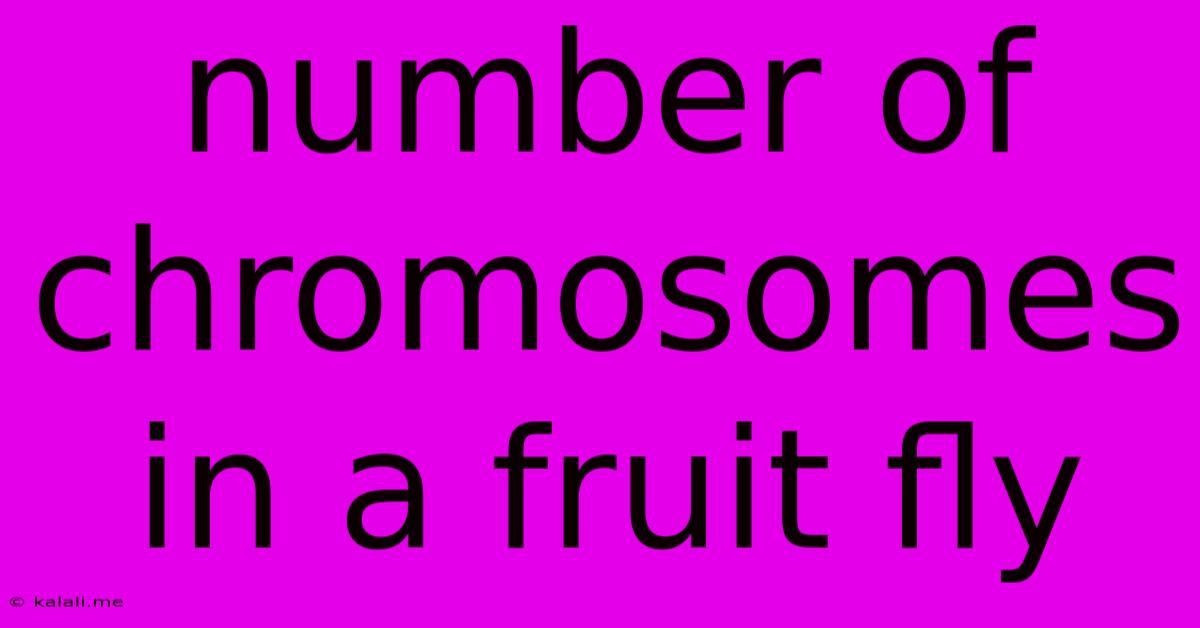Number Of Chromosomes In A Fruit Fly
Kalali
Jun 13, 2025 · 3 min read

Table of Contents
Decoding the Drosophila Genome: How Many Chromosomes Does a Fruit Fly Have?
Fruit flies, scientifically known as Drosophila melanogaster, are tiny insects that have played a gigantic role in advancing our understanding of genetics and biology. Their relatively simple genome, short lifespan, and ease of breeding make them ideal model organisms for scientific research. But how many chromosomes do these unassuming creatures actually possess? This article delves into the fascinating world of Drosophila chromosomes and explores their significance in genetic studies.
Understanding Chromosomes: The Blueprint of Life
Chromosomes are thread-like structures located inside the nucleus of cells. They are made up of DNA (deoxyribonucleic acid), which carries the genetic instructions for the development, functioning, and reproduction of all known organisms. Each chromosome contains numerous genes, the fundamental units of heredity. The number of chromosomes varies greatly across species. Humans, for example, have 46 chromosomes (23 pairs).
The Chromosome Count of Drosophila Melanogaster
Unlike humans, fruit flies have only four pairs of chromosomes, totaling eight chromosomes. This relatively small number of chromosomes makes them a much simpler organism to study genetically compared to other species with much larger genomes. These four chromosome pairs are often denoted as:
- Chromosome Pair 1 (X and Y): These are the sex chromosomes. Females have two X chromosomes (XX), while males have one X and one Y chromosome (XY).
- Chromosome Pairs 2, 3, and 4: These are the autosomes, meaning they are not involved in sex determination. They carry genes that control various other traits and functions in the fly.
The Significance of Drosophila's Chromosome Number in Genetic Research
The manageable number of chromosomes in Drosophila melanogaster has been instrumental in numerous groundbreaking discoveries in genetics. Scientists have used fruit flies to:
- Map genes: The relatively small number of chromosomes makes it easier to map the location of genes on the chromosomes.
- Study mutations: The ease of breeding and short generation time allows researchers to readily observe and study the effects of mutations.
- Understand genetic regulation: Drosophila has been crucial in understanding how genes are regulated and expressed.
- Model human diseases: Many genes in Drosophila are homologous to human genes, making it a useful model for studying human diseases.
Beyond the Chromosome Count: Exploring the Drosophila Genome
While the chromosome number provides a foundational understanding of the fly's genetic makeup, the complete picture also includes the intricate details of the genome itself. Researchers have extensively sequenced the Drosophila genome, revealing a wealth of information about gene function, regulation, and evolution. This detailed genetic information continues to power advancements in various fields, including medicine, agriculture, and evolutionary biology.
Conclusion: A Tiny Insect, a Giant Leap for Genetics
The seemingly simple number – eight chromosomes – belies the profound impact of Drosophila melanogaster on our understanding of genetics. The relatively low chromosome count, combined with other favorable characteristics, has made it a cornerstone of genetic research, leading to countless discoveries that have shaped our understanding of life itself. Its continued use in scientific research ensures that the fruit fly will remain a crucial model organism for years to come, continually contributing to advancements in various fields of biological study.
Latest Posts
Latest Posts
-
What Are The Spectator Ions In This Equation
Jun 14, 2025
-
A Reaction Will Be Spontaneous At All Temperatures If
Jun 14, 2025
-
Case Western Reserve University Average Gpa
Jun 14, 2025
-
Are Zooplankton Herbivores Carnivores Or Omnivores
Jun 14, 2025
-
What Are The Multiples Of 13
Jun 14, 2025
Related Post
Thank you for visiting our website which covers about Number Of Chromosomes In A Fruit Fly . We hope the information provided has been useful to you. Feel free to contact us if you have any questions or need further assistance. See you next time and don't miss to bookmark.